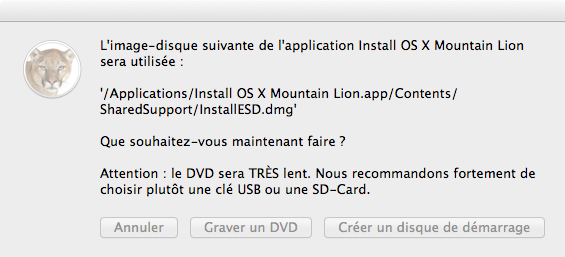Create Install Disk For Lion
- 14 Comments!

- Target Disk Mode (sometimes referred to as TDM or Target Mode) is a boot mode unique to Macintosh computers. When a Mac that supports Target Disk Mode is started with.
- IHackintosh guide to install OS X Mountain Lion 10.8 in a virtual machine with VMware 8 and Windows 7 host.
- The hard drive is the primary storage location for all of your computer's data. If you run out of that storage, installing a.
- I've found a way to get a full Lion installer by capturing the installer files that the recovery partition downloads. This seems to work on my 2008 MBP machine with.
- Is your PC compatible with Mac OS X? Read this first. How to install OS X El Capitan on your PC with Unibeast; How to use Multibeast 8: a comprehensive guide.
- You'll need to create a new hard disk for the virtual machine. Virtualbox will ask you what type of disk you want to create: VDI, VDMK, or VHD.
After last week's article, "Pro tip: How to create a bootable USB drive to install Windows on OS X," I received feedback asking why anyone would install Windows on a. Eye On Fusion Projector 3D Volume.
How to get a full Lion install disc for a new Mac. Book Air or Pro. I've found a way to get a full Lion installer by capturing the installer files that the recovery partition downloads. This seems to work on my 2.
Create Install Disk For Lions
You can set Encryption if you want but not necessary. On the other hand, encrypting the disk image is a good idea since you’re going to put it on a network that can.
MBP machine with the App Store version of Lion installed on it, but it should be of particular interest to users of the new Mac. Book Airs and Mac. Book Pros which don't come with an install disk, but can't install the App Store version of Lion. By following this hint, it should be possible to get a full Lion install disk for those machines that won't require network access to install. An external hard drive or separate partition is great. A large USB flash drive might work, but I haven't tried it. Unfortunately, it deletes itself after installation, so it doesn't give you a chance to make a boot disk that doesn't involve network access.
However, it is possible to capture the installer and interrupt the install, so that it doesn't get a chance to delete itself. It will be something of the form disk. Xs. Y, where X and Y are numeric digits. So on my machine, I typed.
Only /dev/disk. 0s. The disk image inside the recovery HD is invisible, so use the Terminal to mount that too. Surprisingly, it launches, even when booted into a standard Mac OS X user account from the hard drive!
Go through the license agreement. Once it asks you for a disk to install on, choose the external drive or spare partition.
As long as you don't let the installer reboot, it shouldn't be able to install anything, but I like to err on the side of caution.)Enter your admin password when prompted, and the installer will start downloading. Open an old- style (non- autosaving) application that still uses the traditional Save, Save As.., etc. This will give you a little insurance against the installer rebooting the system, since the app won't let the system reboot until you respond to its message asking whether you want to save the document or not. The installer will start downloading some packages into a folder called Mac OS X Install Data on the root of the drive you're installing onto. Of the files it puts in there, the interesting item is a package with a funky name (on my system, it was 'mzm. It will be the file in the folder with the largest file size. Once the file finishes downloading, the installer will extract the Install.
ESD. dmg image from it and delete the package. This will be fine as long as you don't let the app restart your machine. Wait for the download to finish. This will probably take a while, as it's a very large download. Once the installer finishes download and prompts you to restart your Mac, force- quit it. Do this quickly, as it may automatically reboot for you after a timeout period (although if you've got an unsaved document open, you should be able to prevent that). You should now have a file called Install.
ESD. dmg in the Mac OS X Install Data folder. You can burn this to a DVD, or image it to a USB flash drive to create a boot disk.